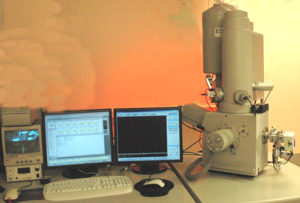Difference between revisions of "Scanning Electron Microscope"
Cmditradmin (talk | contribs) m |
Cmditradmin (talk | contribs) m (→Operation) |
||
| Line 17: | Line 17: | ||
=== Operation === | === Operation === | ||
Part 1 Tour and Sample Preparation | Part 1 Tour and Sample Preparation | ||
{{#ev:youtube| | {{#ev:youtube|QBo_JyRfV3E}} | ||
Part 2 Loading the Sample | Part 2 Loading the Sample | ||
{{#ev:youtube| | {{#ev:youtube|QzDecvtha8k}} | ||
Part 3 Setting the Working Distance | Part 3 Setting the Working Distance | ||
{{#ev:youtube| | {{#ev:youtube|N3cY7b5ySLU}} | ||
Part 4 Lens Alignment and Stigmation | Part 4 Lens Alignment and Stigmation | ||
{{#ev:youtube| | {{#ev:youtube|JM8RQ4kQ3UM}} | ||
Part 5 Moving the Stage and Imaging | Part 5 Moving the Stage and Imaging | ||
{{#ev:youtube| | {{#ev:youtube|2FAsV9bZB_c}} | ||
Part 6 Changing the Sample and Shutdown | Part 6 Changing the Sample and Shutdown | ||
{{#ev:youtube| | {{#ev:youtube|oW7xbCM2LZo}} | ||
Revision as of 14:20, 6 January 2010
| Return to Research Tool Menu |
Overview
The scanning electron microscope is used to image the surface of a conducting sample by scanning it with a high energy beam of electrons. Some SEMs have additional software enhancements than enable them to focus the beam on a photomask for E-beam lithography or are equipped for focused ion beam (FIB) milling. The SEM is a useful tool for photonics research because it reveals nano-scale surface features and topography that is critical to the performance of multi-layer devices.
See Wikipedia on Scanning Electron Microscope
Operation
Part 1 Tour and Sample Preparation
Part 2 Loading the Sample
Part 3 Setting the Working Distance
Part 4 Lens Alignment and Stigmation
Part 5 Moving the Stage and Imaging
Part 6 Changing the Sample and Shutdown
Training Manual for Sirion SEM[1]
Training Video on Hitachi 3500H SEM at GT MiRC
